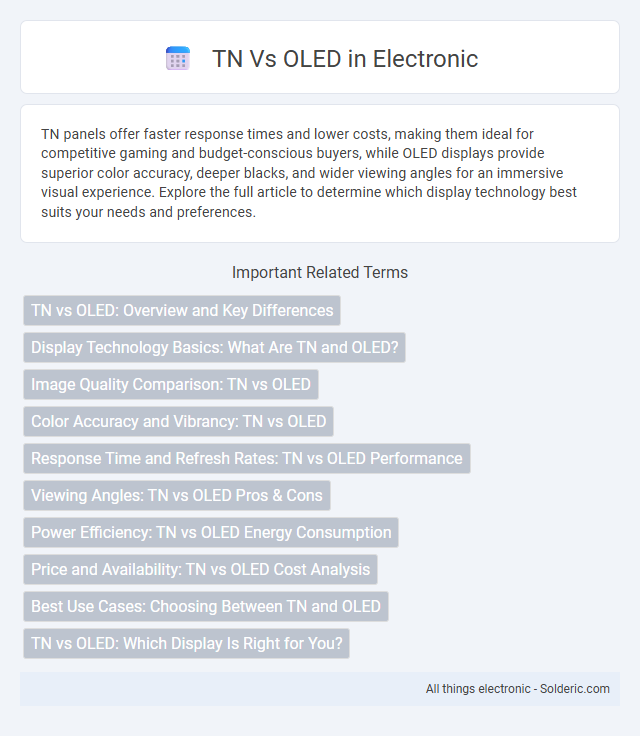TN panels offer faster response times and lower costs, making them ideal for competitive gaming and budget-conscious buyers, while OLED displays provide superior color accuracy, deeper blacks, and wider viewing angles for an immersive visual experience. Explore the full article to determine which display technology best suits your needs and preferences.
Comparison Table
| Feature | TN (Twisted Nematic) | OLED (Organic Light Emitting Diode) |
|---|---|---|
| Response Time | 1-2 ms (fastest) | 0.1-1 ms (ultra-fast) |
| Color Accuracy | Lower, limited color range | Excellent, wide color gamut (100% DCI-P3) |
| Viewing Angles | Narrow, color shifts at angles | Wide, color and contrast remain consistent |
| Contrast Ratio | 1,000:1 typical | Infinite (true blacks) |
| Black Levels | Grayish blacks | True black with pixel-level illumination |
| Brightness | High brightness, up to 400 nits | Moderate brightness, 400-800 nits typical; HDR up to 1000 nits+ |
| Power Consumption | Lower power usage (LCD backlight) | Variable, can be higher or lower depending on content |
| Price | More affordable | Costlier |
| Lifespan | Long, stable over time | Shorter, potential burn-in risk |
| Use Cases | Budget gaming, office monitors | High-end smartphones, TVs, professional graphics |
TN vs OLED: Overview and Key Differences
TN panels offer faster response times and lower production costs, making them ideal for budget gaming monitors, while OLED displays provide superior color accuracy, deeper blacks, and wider viewing angles due to their self-emissive pixel technology. TN technology relies on liquid crystals aligned in a twisted nematic configuration, resulting in lower contrast ratios and limited viewing angles compared to OLED's emissive organic compounds that produce light individually at each pixel. OLED screens deliver vibrant visuals with true blacks and energy efficiency advantages, whereas TN panels prioritize speed and affordability, highlighting key differences suitable for various user needs.
Display Technology Basics: What Are TN and OLED?
TN (Twisted Nematic) and OLED (Organic Light Emitting Diode) are two distinct display technologies used in screens. TN panels control light using liquid crystals aligned twistedly to quickly change pixels, offering fast response times but limited color accuracy and viewing angles. OLED displays feature self-emissive pixels that emit light individually, delivering superior contrast, vibrant colors, and deeper blacks for a richer visual experience.
Image Quality Comparison: TN vs OLED
OLED panels deliver superior image quality compared to TN displays due to their ability to produce true blacks, higher contrast ratios, and richer, more vibrant colors. TN screens often suffer from limited viewing angles and lower color accuracy, resulting in washed-out images especially when viewed off-center. Your visual experience is greatly enhanced with OLED's pixel-level illumination, providing sharper, more immersive visuals ideal for gaming, media, and professional use.
Color Accuracy and Vibrancy: TN vs OLED
OLED panels deliver superior color accuracy and vibrancy compared to TN displays due to their self-emissive pixels, enabling deeper blacks and a wider color gamut. TN panels typically exhibit limited color reproduction and narrower viewing angles, resulting in less vivid colors and potential color shifting. For applications requiring precise color fidelity and rich visuals, OLED technology is the preferred choice over TN.
Response Time and Refresh Rates: TN vs OLED Performance
TN panels typically offer faster response times, often as low as 1ms, making them ideal for competitive gaming where motion blur must be minimized. OLED displays provide excellent refresh rates, commonly 120Hz or higher, combined with near-instantaneous pixel response due to their self-emissive nature, resulting in smooth motion and vibrant visuals. While TN excels in raw speed and low input lag, OLED delivers superior contrast and color accuracy without sacrificing fluid motion, making it a compelling choice for immersive gaming and multimedia.
Viewing Angles: TN vs OLED Pros & Cons
OLED displays offer superior viewing angles compared to TN panels, maintaining consistent colors and contrast even when viewed from sharp angles. TN screens tend to suffer from color shifting and reduced brightness at wider viewing angles, limiting their effectiveness for collaborative or multi-angle viewing environments. Your choice may depend on whether wide viewing angles or faster response times are a higher priority in your display needs.
Power Efficiency: TN vs OLED Energy Consumption
OLED displays consume less power than TN panels when displaying darker images due to their ability to turn off individual pixels, resulting in improved energy efficiency for black or dim content. TN panels typically draw more consistent power regardless of image content because their backlighting remains fully on at all times. Overall, OLED technology offers superior energy savings in environments with variable brightness, enhancing battery life for portable devices.
Price and Availability: TN vs OLED Cost Analysis
TN panels are generally more affordable and widely available compared to OLED displays, making them a cost-effective choice for budget-conscious consumers. OLED technology, while offering superior color accuracy and contrast, tends to come at a premium price and is less commonly found in entry-level monitors and TVs. If you prioritize budget and accessibility, TN displays provide a practical option without compromising basic performance.
Best Use Cases: Choosing Between TN and OLED
TN panels excel in fast-paced gaming and office tasks due to their high refresh rates and low response times, providing smooth motion and reduced input lag. OLED displays are ideal for media consumption, graphic design, and photography with their superior color accuracy, deep blacks, and wide viewing angles. Choose TN if you prioritize performance and affordability for competitive gaming, while OLED suits you best if vivid visuals and immersive experiences are your main focus.
TN vs OLED: Which Display Is Right for You?
TN displays offer faster response times and cost-effective pricing, making them ideal for competitive gamers and budget-conscious users. OLED panels provide superior color accuracy, deeper blacks, and wider viewing angles, enhancing your visual experience for multimedia and creative work. Your choice depends on whether you prioritize speed and affordability or vibrant, high-quality visuals.
TN vs OLED Infographic

 solderic.com
solderic.com